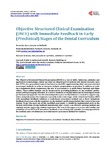Objective Structured Clinical Examination (OSCE) with Immediate Feedback in Early (Preclinical) Stages of the Dental Curriculum
| dc.contributor.author | Zaric, Svetislav | |
| dc.contributor.author | Belfield, Louise | |
| dc.date.accessioned | 2015-05-23T13:45:49Z | |
| dc.date.available | 2015-05-23T13:45:49Z | |
| dc.date.issued | 2015-04-17 | |
| dc.identifier.issn | 2151-4755 | |
| dc.identifier.issn | 2151-4771 | |
| dc.identifier.uri | http://hdl.handle.net/10026.1/3346 | |
| dc.description.abstract |
The Objective Structured Clinical Examination (OSCE) is a test of skills, behaviour, attitudes and application of knowledge, which has been an integral part of medical and dental curricula since late 1970s. As a procedural exam, it has been successfully supplementing other outcome-oriented assessment methods in order to measure students’ preparedness to practice. In addition to making a judgement about competence, the aim of assessment is to guide future learning and shape values. These added benefits can be harnessed by providing feedback on the students’ performance and encouraging reflection. As a tool to reinforce or modify behaviour by focusing on actual performance (compared with the intended performance level), feedback is central to support cognitive and professional development, especially in the early stages of the clinical curriculum. OSCE with immediate feedback combines a work-based assessment method and a short, immediate feedback discussion with the examiner on the student’s performance before they move to the next station. To get the most out of this modified assessment, it should be implemented early in the clinical curriculum. Giving feedback immediately after a task is an efficient learning method and valuable tool for improving student experience. The aim of this paper is to assess the validity and reliability of the OSCE with immediate feedback as an exciting and valuable learning opportunity for students and a revolutionary new informative assessment method for teachers. | |
| dc.format.extent | 585-593 | |
| dc.language.iso | en | |
| dc.publisher | Scientific Research Publishing, Inc. | |
| dc.title | Objective Structured Clinical Examination (OSCE) with Immediate Feedback in Early (Preclinical) Stages of the Dental Curriculum | |
| dc.type | journal-article | |
| dc.type | Article | |
| plymouth.issue | 06 | |
| plymouth.volume | 06 | |
| plymouth.publication-status | Published | |
| plymouth.journal | Creative Education | |
| dc.identifier.doi | 10.4236/ce.2015.66058 | |
| plymouth.organisational-group | /Plymouth | |
| plymouth.organisational-group | /Plymouth/Faculty of Health | |
| plymouth.organisational-group | /Plymouth/Faculty of Health/Peninsula Dental School | |
| plymouth.organisational-group | /Plymouth/REF 2021 Researchers by UoA | |
| plymouth.organisational-group | /Plymouth/REF 2021 Researchers by UoA/UoA01 Clinical Medicine | |
| plymouth.organisational-group | /Plymouth/Research Groups | |
| plymouth.organisational-group | /Plymouth/Research Groups/Institute of Translational and Stratified Medicine (ITSMED) | |
| plymouth.organisational-group | /Plymouth/Research Groups/Institute of Translational and Stratified Medicine (ITSMED)/CBR | |
| plymouth.organisational-group | /Plymouth/Users by role | |
| plymouth.organisational-group | /Plymouth/Users by role/Academics | |
| dcterms.dateAccepted | 2015-04-10 | |
| dc.identifier.eissn | 2151-4771 | |
| dc.rights.embargoperiod | Not known | |
| rioxxterms.versionofrecord | 10.4236/ce.2015.66058 | |
| rioxxterms.licenseref.uri | http://www.rioxx.net/licenses/all-rights-reserved | |
| rioxxterms.type | Journal Article/Review |


